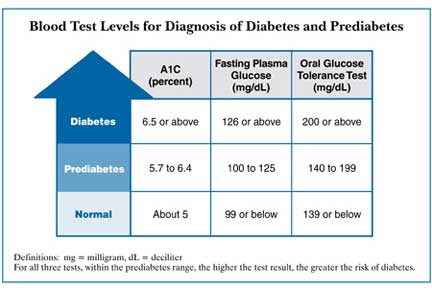
Diabetes is a group of metabolic diseases in which there are high blood sugar levels over a prolonged period. This high blood sugar produces the symptoms of frequent urination, increased thirst, and increased hunger. Untreated, diabetes can cause many complications. Acute complications include diabetic ketoacidosis and nonketotic hyperosmolar coma. Serious long-term complications include heart disease, stroke, kidney failure, foot ulcers and damage to the eyes.
Major types of diabetes mellitus
TYPE1 Diabetes:
Results from the body's failure to produce insulin, the hormone that "unlocks" the cells of the body, allowing glucose to enter and fuel them.
TYPE2 Diabetes:
Results from insulin resistance (a condition in which the body fails to properly use insulin), combined with relative insulin deficiency. Major group of diabetics belong to this category.
Gestational Diabetes:
Gestational diabetes affects about 4% of all pregnant women.
Pre Diabetes:
Pre-diabetes is a condition that occurs when a person's blood glucose levels are higher than normal but not high enough for a diagnosis of type II diabetes. This group of people can actually reverse their chances of getting diabetes in future by appropriate dietary and lifestyle changes.
How are diabetes and pre-diabetes diagnosed?
Blood tests are used to diagnosis diabetes and pre-diabetes because early in the disease type 2 diabetes may have no symptoms. All diabetes blood tests involve drawing blood at a health care provider’s office or commercial facility and sending the sample to a lab for analysis. Lab analysis of blood is needed to ensure test results are accurate. Glucose measuring devices used in a health care provider’s office, such as finger-stick devices, are not accurate enough for diagnosis but may be used as a quick indicator of high blood glucose.
Testing enables health care providers to find and treat diabetes before complications occur and to find and treat pre-diabetes, which can delay or prevent type 2 diabetes from developing.
Any one of the following tests can be used for diagnosis:*
- an A1C test, also called the hemoglobin A1c, HbA1c, or glycohemoglobin test
- a fasting plasma glucose (FPG) test
- an oral glucose tolerance test (OGTT)
*Not all tests are recommended for diagnosing all types of diabetes. See the individual test descriptions for details.
Another blood test, the random plasma glucose (RPG) test, is sometimes used to diagnose diabetes during a regular health checkup. If the RPG measures 200 micrograms per deciliter or above, and the individual also shows symptoms of diabetes, then a health care provider may diagnose diabetes.
Symptoms of diabetes include
- Increased urination
- Increased thirst
- Unexplained weight loss
Other symptoms can include fatigue, blurred vision, increased hunger, and sores that do not heal.
Any test used to diagnose diabetes requires confirmation with a second measurement unless clear symptoms of diabetes exist.
The following table provides the blood test levels for diagnosis of diabetes for non-pregnant adults and diagnosis of pre-diabetes.
The following table provides the blood test levels for diagnosis of diabetes for non-pregnant adults and diagnosis of pre-diabetes.



























































 Address 1
Address 1
